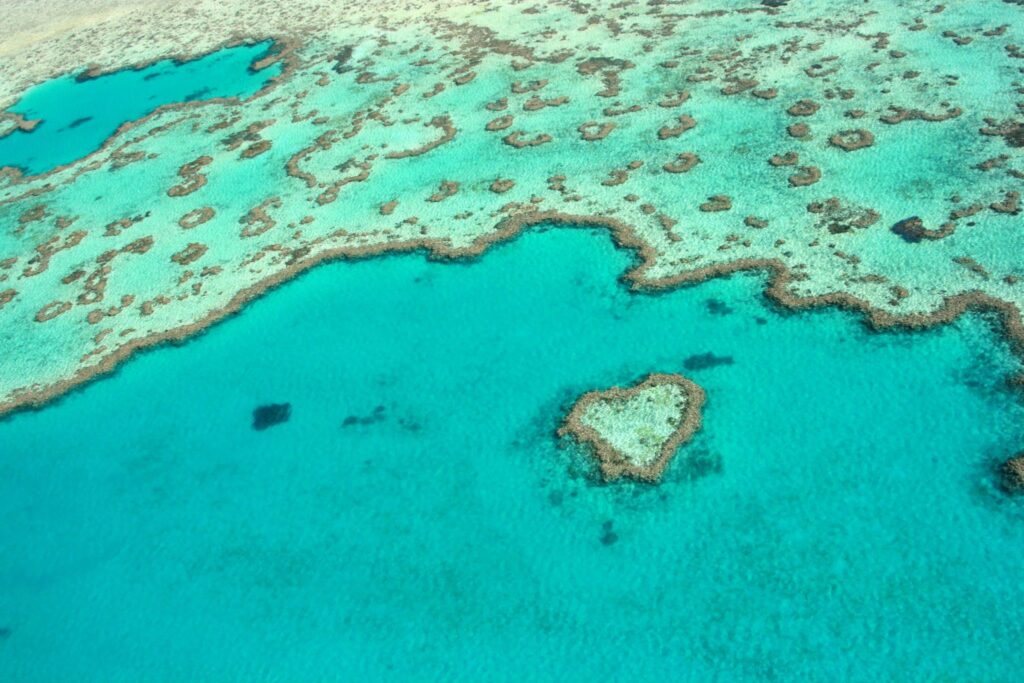When asked to pick a place he’d love to revisit, Sir David Attenborough replied: “A coral reef, with its sheer magnitude of different, wonderful, beautiful things.”
Reefs weave through oceans across our globe, but there is no system more famous than Australia’s Great Barrier Reef, a natural phenomenon so vast and dramatic, it can be seen from space. A collection of 2900 individual reefs and 900 islands stretching more than 2300km, it’s a spectacle of colourful critters, mighty marine mammals and curious deep-sea organisms.
Of course, the opportunities for snorkelling and scuba are outstanding, but, as Sir Attenborough points out, “You don’t need to be a great underwater swimmer to see the miracle of a flourishing coral reef.”
There are alternative options for underwater sleeps, walk-though observatories and aerial tours for a bird’s-eye view. Spend time planning a perfect trip by diving into some of these suggestions.
How can I see the reef without getting wet?
From glass-bottomed boats to underwater galleries and even bedrooms, there are many ways to marvel at marine life without getting even slightly wet. Located on the Great Barrier Reef, close to the Whitsundays, the Reefsuites pontoon features two submerged rooms with floor to ceiling windows, providing views of tropical fish, turtles and manta rays. All-inclusive stays cost from $899 per person per night. There’s also an option to sleep out under the stars on deck, in several comfortable pods.
Nearby, the split-level Heart Island pontoon provides an opportunity for guests to explore the Instagram-favourite Heart Reef lagoon. Appreciate exactly how the much-loved coral formation earned its name by gazing from above on a helicopter ride. Visit here.

Which are the best islands for a remote, rustic experience?
Imagine days spent swinging on hammocks, listening to surf rhythmically lap sandy shores. Desert island paradise is summed up perfectly on Pumpkin Island, a low-key 6.1-hectare patch of land set along the Capricorn Coast in the southern part of the Great Barrier Reef Marine Reserve, just off the coast of Yeppoon. Stay overnight (or longer) in five cottages and two beach bungalows, where electricity is provided by wind and solar power, and rainwater is filtered for drinking. Gather enough friends and family together and it’s possible to rent the whole place for a reasonable rate; split between 34 people, a seven-night stay works out at $62 per night. Visit here.
Also along the southern stretch of the reef, Wilson Island reopened to guests in late 2019. Only accessible from neighbouring Heron Island on a 30-minute boat ride, it’s a sleepy coral cay, where there are no phones, TV or wifi. There are nine luxury Reef Safari Tents hidden in an ancient Pisonia forest, with meals served in a central dining area. Along with following nature trails or exploring on a SUP, activities include a chance to see turtles nesting and hatching. The island closes every year from February to April, to allow the resident bird population the peace and quiet they need to nest. A two-night all-inclusive stay costs $2245 twin share. Visit here.
What about a high-end option?
Describing her family’s elite hideaway, hotelier Anna Turner refers to Haggerstone Island as the “best place to shake the world out of people”. A two-hour flight north from Cairns, and a 40-minute flight from the nearest town, it features five high-end beachfront huts, inspired by a mixture of African and Papua New Guinean themes. Activities include exploring the reef on a jet boat, flying by helicopter to hidden waterfalls and silica sand dunes, and catching fresh fish for elaborate feasts. Visit here.
Equally intimate but a little more affordable, Elysian Retreat in the Whitsundays is the first fully solar powered resort on the reef, with 10 bungalows dotted along the beach. Meals are prepared with a focus on health and nutrition, while wellbeing treats come in the form of daily yoga classes and massage treatments. All-inclusive stays from $635 per night. Visit here.
Where can I get a glimpse of research work in action?
Long-regarded as one of Australia’s most idyllic tropical island retreats, Lizard Island is also home to an acclaimed research station, attracting coral reef researchers from around the globe. Approximately 100 different projects are now conducted annually, generating more than 1200 scientific publications since 1973. Guests staying in the island’s 40 beach house suites can visit the Research Station on a guided tour, to find out about the work being done. Visit here.
For a more hands-on experience, Daydream Island Resort in the Whitsundays has a man-made Living Reef, ideal for families to learn about what happens beneath the waves. A coral lagoon wrapping 200m around the resort hosts more than 100 species of local marine life. Resident marine biologists lead a range of activities, including tours of an underwater observatory and an interactive touch pool. A collection of new raceways, tanks with an inlet and outlet enabling a simulation of tides, are also used for coral propagation. Visit here.
Have you visited the Great Barrier Reef? Where did you stay? What did you see? Share your favourite memory in the comments section below.
– With PA
If you enjoy our content, don’t keep it to yourself. Share our free eNews with your friends and encourage them to sign up.

